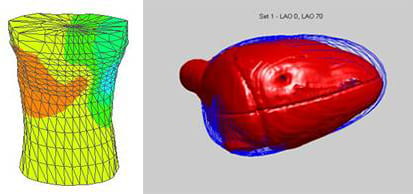Background | Theory | Computational Implementation | Experimental Validation
Computational Implementation
The goal of ECGI is to reconstruct the electric potential distribution on the surface of the heart (epicardium) form potential data measured on the torso. The numerical solution for the ECGI inverse computation requires two steps: (1) derivation of a mathematical formulation that expresses the potential field throughout the torso volume conductor and in particular on the body surface, as a function of the epicardial potential (the forward problem); (2) inversion of this expression to compute epicardial potentials from the measured torso potential data (the inverse problem).
THE FORWARD SOLUTION
To solve the Cauchy problem for the Laplace operator in an irregular geometry such as the human heart-torso configuration, it is necessary to apply numerical methods. There are several numerical methods available including the Finite Element Method (FEM), and the Boundary Element Method (BEM). Each method has its own advantages and is suited for a particular class of problems.
For the ECGI problem, BEM is a natural choice, because only the torso and heart surfaces are involved and require discretization (meshing) as shown in the figure below. FEM, in contrast, requires discretization of the entire 3D volume of the torso.

Using BEM, Laplace’s Equation is discretized into the following form:
VT =A*VE
where VT is a vector of torso potentials,VE is a vector of epicardial potentials, and A is a transfer matrix between the heart and the torso that depends only on the geometry.
THE INVERSE SOLUTION
Although the solution to the Cauchy problem is unique, because the inverse problem is ill-posed, one cannot simply invert the A matrix to compute VE from VT; even low-level noise in the measured data (VT) can cause unbounded error in the solution (VE). Techniques of regularization must therefore be used to minimize the effects of such error by imposing constraints on the solution.
Several approaches are available to regularize ill-posed problems. We implemented the Tikhonov regularization scheme, in which single parameter minimization is used to find VE.

C. Ramanathan, P. Jia, R.N. Ghanem, D. Calvetti, Y. Rudy , “Noninvasive Electrocardiographic Imaging (ECGI): Application of the Generalized Minimal Residual (GMRes) Method” Annals of Biomedical Engineering 2003; 31:981-994
We also adopted an iterative approach, the General Minimal Residual (GMRes) method as a second method for computing VE from VT.